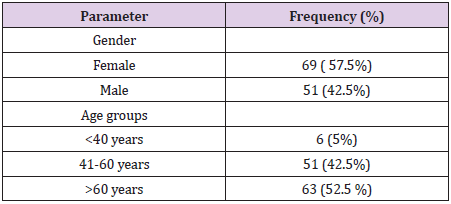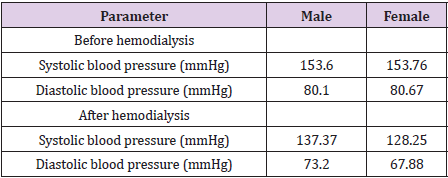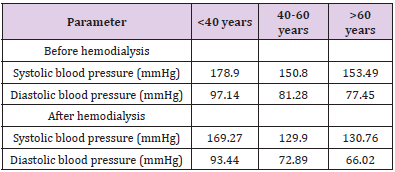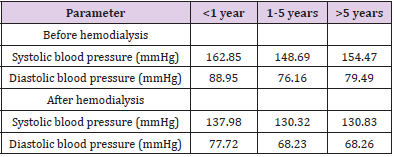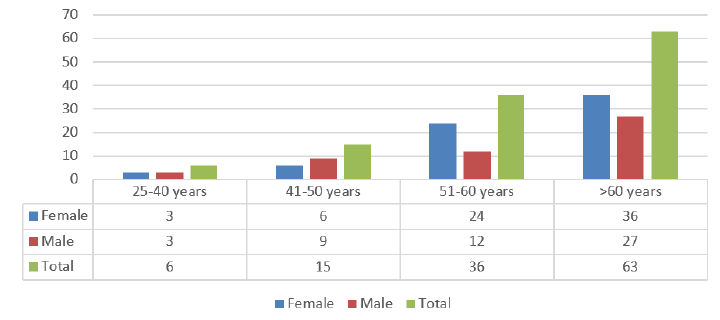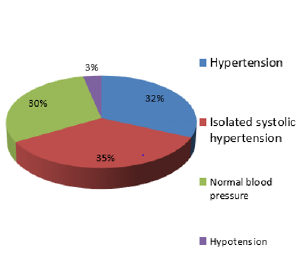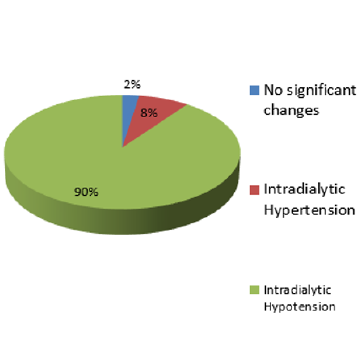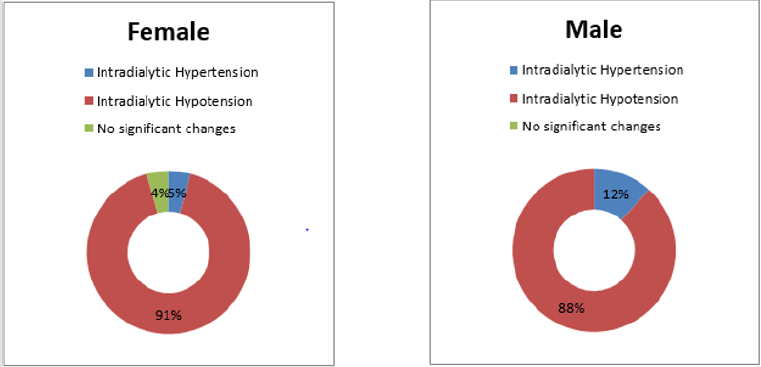Abstract
Introduction: Studies have shown that high systolic and diastolic blood pressure in patients, along with known risk factors for cardiovascular disease, are associated with end-organ damage, vascular stiffness and poor outcomes in hemodialysis patients.
Purpose of Research: The purpose of this paper is to provide a clear overview of the presence of hypertension in patients at the Hemodialysis Center, at the Nephrology Clinic and to present the results obtained from this research.
Methodology: This study was a prospective study conducted at the Hemodialysis Center at the Nephrology Clinic, University Clinical Center of Kosovo, that involved patients with renal disease undergoing hemodialysis. This study included 120 patients.
Results: According to gender of the patients, there were 69 (57.5%) females, and 51 (42.5%) males. Mean systolic and diastolic blood pressure before hemodialysis were higher compared to values after hemodialysis. Blood pressure variation observed post hemodialysis, showed that from 120 patients, 3 (2%) patients had no significant change in systolic blood pressure pre to post hemodialysis, 9 (8%) patients had intradialytic hypertension, while 108 (90%) patients had intradialytic hypotension.
Conclusion: This research has shown that arterial hypertension is a common problem among hemodialysis patients. Prior to the hemodialysis session, 32% of patients were hypertensive (with elevated systolic and diastolic blood pressure), while in 35% of patients isolated systolic hypertension was present. After the hemodialysis session, 90% of patients had lower mean systolic and diastolic blood pressure than before hemodialysis session.
Keywords: Hemodialysis; Blood pressure
Abbreviations: ESRD: End-Stage Renal Disease; RRT: Renal Replacement Therapy; ABPM: Ambulatory Blood Pressure Monitoring; ABP: Ambulatory Blood Pressure
Introduction
It is essential to understand the mechanism, to evaluate and determine the good management of patients undergoing Renal Replacement Therapy (RRT) such as hemodialysis. Patients with End-Stage Renal Disease (ESRD) need renal replacement therapy for survival [1]. Blood pressure is frequently measured in hemodialysis centers, but there is often dissatisfaction related to the measurement technique by health workers, therefore, to determine blood pressure during hemodialysis, blood pressure is measured before, several times during and after hemodialysis session and also home and Ambulatory Blood Pressure (ABP) measurements are performed. Many authors suggest that Ambulatory Blood Pressure Monitoring (ABPM) is considered the ‘gold standard’ method for diagnosing hypertension in hemodialysis patients [2]. In patients with End Stage Renal Disease (ESRD) undergoing hemodialysis elevated blood pressure is a common condition and is not adequately controlled [3].
Main pathogenic mechanisms of hypertension in hemodialysis patients are: Sodium and volume overload, increased arterial stiffness, activation of the renin-angiotensin- aldosterone system, activation of sympathetic nervous system, endothelial dysfunction imbalance between endothelium-derived vasodilators and vasoconstrictors), high prevalence of sleep apnoea and use of recombinant erythropoietin’s [4]. Increased arterial pressure is associated with increased risk for left ventricular hypertrophy, coronary artery disease, heart failure, cerebrovascular complications, and death [5]. The correlation between hypertension and cardiovascular disease risk in hemodialysis patients is poorly understood, and still present paradoxical reports [6]. Many studies have shown that high systolic and diastolic blood pressure in patients, along with known risk factors for cardiovascular disease, are associated with end-organ damage, vascular stiffness and poor outcomes in hemodialysis patients [7].
Purpose of Research
The purpose of this paper is to provide a clear overview of the presence of hypertension in patients at the Hemodialysis Center, at the Nephrology Clinic, University Clinical Center of Kosovo and to present the results obtained from this research. We aimed to report the prevalence of hypertension in hemodialysis patients and to show differences between mean blood pressure values before and after hemodialysis, according to gender, age of patients and length of time on hemodialysis.
Material and Methods
This study was a prospective study conducted at the Hemodialysis Center at the Nephrology Clinic, University Clinical Center of Kosovo, that involved patients with renal disease undergoing hemodialysis. This study included 120 patients. Data included age, gender, length of time on hemodialysis, systolic and diastolic blood pressure values at onset of hemodialysis and at the end of hemodialysis. Blood pressure values were monitored throughout the hemodialysis sessions over a six-month period, January-June 2019. Hypertension was defined as mean arterial pressure prior to hemodialysis session SBP>150mmHg and/or DBP>85mmHg [8]. The statistical method used is the arithmetic mean. The results are shown in (Tables 1-5) and (Figures 1-4).
Figure 4: Arterial blood pressure variation observed in patients after hemodialysis according to gender.
Results
At the Hemodialysis Center at the Nephrology Clinic, University Clinical Center of Kosovo, arterial blood pressure values of 120 patients undergoing hemodialysis were observed over a six-month period, January-June, 2019. According to gender, there were 69 (57.5%) females, and 51 (42.5%) males. According to age, patients aged <40 years were 6 (5%), patients aged 41-60 years were 51 (42.5%), while patients aged >60 years were 63 (52.5 %). Mean age of patients was 58 years. Considering the length of time these patients were involved in hemodialysis, under 1 year were 24 (20%), 1-5 years were 54 (45%), and over 5 years were 42 (35%). Mean systolic and diastolic blood pressure before hemodialysis were higher compared to values after hemodialysis. Mean systolic and diastolic blood pressure variation observed before hemodialysis were as follows: 38 (32%) patients resulted with mean systolic pressure >150 and mean diastolic pressure >85 (hypertension), 42 (35%) patients resulted with mean systolic blood pressure >140 and mean diastolic pressure <90 (isolated systolic hypertension), 36 (30%) patients resulted with normal blood pressure values and 4 (3%) patients were hypotensive before hemodialysis.
Mean systolic and diastolic blood pressure values prior to hemodialysis had no significant difference between female and male patients but mean systolic and diastolic blood pressure values after hemodialysis in male patients were higher than those of female patients after hemodialysis. According to age, patients <40 years of age had higher mean systolic blood pressure values, before and after hemodialysis, than the other age groups. Considering the length of time on hemodialysis, it is observed that mean systolic blood pressure is higher in patients that received hemodialysis for less than one year. Mean systolic and diastolic blood pressure variation observed post hemodialysis were as follows: 3 (2%) patients had no significant systolic blood pressure changes after hemodialysis, 9 (8%) patients had intradialytic hypertension and 108 (90%) patients had intradialytic hypotension.
Discussion
Hypertension is a common problem among hemodialysis patients. The prevalence of hypertension in this study is 67%. The population studied consisted of 120 patients observed at the Hemodialysis Center at the Nephrology Clinic, prior to hemodialysis, 38 (32%) patients resulted with mean systolic pressure >150 and mean diastolic pressure >85 (hypertension), 42 (35%) patients resulted with mean systolic pressure >140 and mean diastolic pressure <90 (isolated systolic hypertension), 36 (30%) patients resulted with normal blood pressure values and 4 (3%) patients were hypotensive. 52.23% of hypertensive patients, had isolated systolic hypertension. The mean systolic and diastolic blood pressure values prior to hemodialysis are significantly higher than those after hemodialysis. The effect of intravascular volume excess is commonly observed in hypertensive End-Stage Renal Disease (ESRD) patients and could explain this finding. However, intradialytic hypertension was observed in 9 (8%) patients in the study, where the mean blood pressure values were increased after the hemodialysis session.
The procedure of hemodialysis removes a number of antihypertensive medications and removal of antihypertensive medications could precipitate intradialytic hypertension. Dialysisspecific factors such as: net sodium gain, high ionized calcium and hypokalemia are also thought to play an important role [9]. Fluid overload is also a known cause of intradialytic hypertension [10]. These could possibly be some of the factors contributing to intradialytic hypertension in this study. Mean blood pressure values prior to hemodialysis had no significant difference between female and male patients, but mean blood pressure values after hemodialysis in male patients were higher than those of female patients after hemodialysis. Patients aged < 40 years made up only 5% of the study population, but compared to other age groups, mean systolic pressure values before and after hemodialysis were higher, possibly because arterial stiffening occurs at a younger age. Considering the period of time that patients had been receiving hemodialysis, it is observed that mean systolic blood pressure is higher in patients who had receive hemodialysis in less than one year. Some of the results obtained from our study are similar to the results of a retrospective study of arterial blood pressure of 649 patients at 10 dialysis centers in Mississippi.
Conclusion
This research has shown that arterial hypertension is common among hemodialysis patients. Prior to the hemodialysis session, 32% of patients were hypertensive (with elevated systolic and diastolic blood pressure), while in 35% of patients isolated systolic hypertension was present. After the hemodialysis session, 90% of patients had mean systolic and diastolic blood pressure, lower than before hemodialysis session. However, 8% of patients were affected by intradialytic hypertension, so blood pressure values were increased during hemodialysis and that resulted in hypertension after hemodialysis. This paper informs practitioners and healthcare professionals on this issue in order to properly manage the patient and prevent the onset of complications resulting from hypertension.
References
- Davidson’s Principles & Practice of Medicine, Renal replacement therapy, pp. 491.
- Agarwal R (2015) Pro: Ambulatory blood pressure should be used in all patients on hemodialysis. Nephrol Dial Transplant 30(2): 1432-1437.
- Mailloux LU, Haley WE (1998) Hypertension in the ESRD patient: pathophysiology, therapy, outcomes, and future directions. Am J Kidney Dis 32: 705-719.
- Sarafidis PA, Persu A, Agarwal R, Burnier M, De Leeuw P, et al. (2017) Hypertension in dialysis patients: a consensus document by the European Renal and Cardiovascular Medicine (EURECA-m) working group of the European Renal Association-European Dialysis and Transplant Association (ERA-EDTA) and the Hypertension and the Kidney working group of the European Society of Hypertension (ESH). Nephrol Dial Transplant 32(4): 620-640.
- Foley RN (1996) Impact of hypertension on cardiomyopathy, morbidity and mortality in end-stage renal disease.Kidney International 49(5): 1379-1385.
- Levin NW, Kotanko P, Eckardt KU, Kasiske BL, Chazot C, et al. (2010) Blood pressure in chronic kidney disease stage 5D-report from a Kidney Disease: Improving Global Outcomes controversies conference. Kidney Int 77(4): 273-284.
- Li Z, Lacson E, Lowrie EG, Ofsthun NJ, Kuhlmann MK, et al. (2006) The epidemiology of systolic blood pressure and death risk in hemodialysis patients. Am J Kidney Dis 48(4): 606-615.
- Agarwal R, Nissenson AR, Batlle D, Coyne DW, Trout JR (2003) Prevalence, treatment, and control of hypertension in chronic hemodialysis patients in the United States. Am J Med 115(4): 291-297.
- Inrig Julia K (2009) Intradialytic Hypertension: A Less-Recognized Cardiovascular Complication of Hemodialysis. American Journal of the Kidney Diseases 55(3): 580-589.
- Cirit M, Akçiçek F, Terzioglu E, Soydas C, Ok E, et al. (1995) Paradoxical’ rise in blood pressure during ultrafiltration in dialysis patients. Nephrol Dial Transplant 10: 1417-1420.

 Short Communication
Short Communication